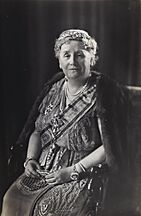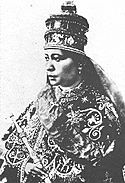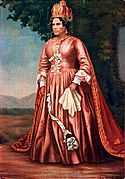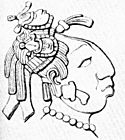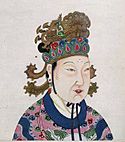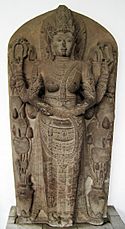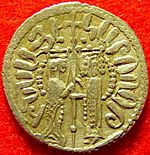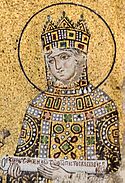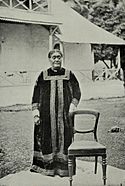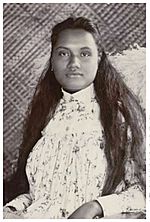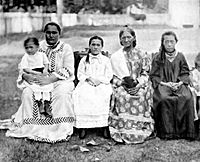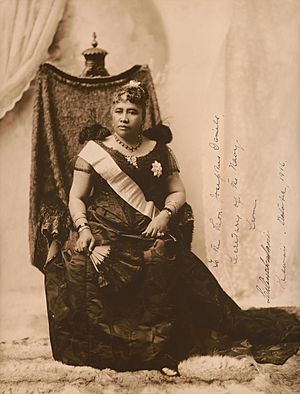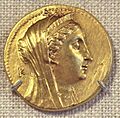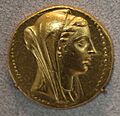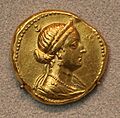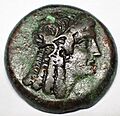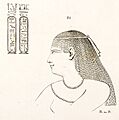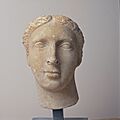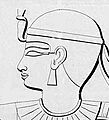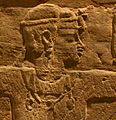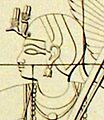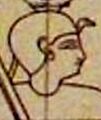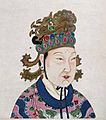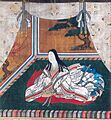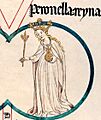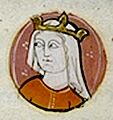List of female monarchs facts for kids
- Top left: Elizabeth II was Queen of the United Kingdom for 70 years. She reigned longer than any other female monarch.
- Top right: Queen Victoria was Queen of the United Kingdom for 63 years. This was the longest reign at that time.
- Bottom left: Wilhelmina, Queen of the Netherlands, ruled from 1890 to 1948. She is the longest-reigning female monarch outside the United Kingdom.
- Bottom right: Margrethe II was Queen of Denmark from 1972 until 2024. She is the most recent female ruler.
This page lists women who have ruled as monarchs in their own right. These include queens, empresses, and pharaohs. It does not include queens who were married to kings (called queens consort). It also does not include women who ruled for a young king (called regents).
This list shares information about well-known female rulers from history. Some very old or less documented rulers, especially from Africa and Oceania, might not be included.
Contents
Female Monarchs Throughout History
Africa
North Africa
Algeria
- Tin Hinan: A queen from the 4th century AD. Her exact reign length is unknown.
Kingdom of the Aurès
- Dihya: She ruled from about 668 to 703 AD, for around 35 years.
Canary Islands
The Canary Islands are Spanish lands located off the coast of North Africa.
Peraza family
- Inés Peraza: Queen from 1452 to 1477, ruling for 25 years.
- Isabella I of Castile: Queen from 1479 to 1504, for over 25 years.
- Joanna of Castile: Queen from 1504 to 1555, for over 51 years.
- Isabella II of Spain: Queen from 1833 to 1868, for 35 years.
Egypt
Pharaonic Egypt The first confirmed female ruler of Egypt was Sobekneferu. However, some earlier queens might have ruled on their own, but the evidence is not clear.
- Sobekneferu: Ruled in the mid-18th century BC for almost 4 years.
- Hatshepsut: Ruled from about 1479 to 1458 BC, for around 21 years.
- Neferneferuaten: Ruled from about 1334 to 1332 BC, for around 3 years.
- Twosret: Ruled from 1191 to 1189 BC, for 2 years.
Ptolemaic Dynasty In this dynasty, kings often ruled with their sisters or wives. Only a few queens ruled completely on their own.
- Arsinoe II: Co-ruled with Ptolemy II from 273/272 to 270/268 BC.
- Berenice II: Co-ruled with Ptolemy III from 246 to 222 BC, for 23 years.
- Cleopatra VII: Officially co-ruled with several kings, but she was the main ruler of Egypt from 52 to 30 BC, for 22 years.
- Zenobia: She took over Roman Egypt and was declared Queen of Egypt from 270 to 272 AD.
- Shajar al-Durr: Ruled for 90 days in 1250.
Libya
- Berenice II: Ruled from 258 to 246 BC, for 12 years.
- Cleopatra Selene II: Ruled from 34 to 30 BC, for 4 years.
Sudan
Kingdom of Kush The title Kandake was used for queens in Nubia. Here are some who ruled:
- Nahirqo: Mid-2nd century BC.
- Amanirenas: Ruled around the end of the 1st century BC to the beginning of the 1st century AD.
- Amanishakheto: Early 1st century AD.
- Amanitore: Mid-1st century AD.
West Africa
Benin
- Hude: Ruled from 1746 to 1752, for 6 years.
The Gambia
- Elizabeth II: Queen of The Gambia from 1965 to 1970.
Ghana
- Elizabeth II: Queen of Ghana from 1957 to 1960.
- Amoako Atta Yiadom: Ruled from 1770 to 1793.
- Ama Serwah: Ruled from 1838 to 1846.
Guinea-Bissau
- Aurelia Correia: Ruled from 1830 to 1874/1879.
- Okinka Pampa Kanyimpa: Ruled from about 1910 to 1930.
Côte d'Ivoire
- Pokou: Ruled around 1750-1760. She was the founder of the Baoule tribe.
- Akwa Boni: Ruled around 1760-1790. She was Pokou's niece.
Nigeria
- Elizabeth II: Queen of Nigeria from 1960 to 1963.
- Aissa Koli: Ruled from 1497 to 1504 or 1563 to 1570.
Daura The title "Kabara" was used by female rulers of the Hausa people in the Middle Ages.
- Daurama: Ruled in the 9th century.
- Orompoto: Ruled from about 1555 to 1575.
Senegal
Lingeers were co-monarchs.
- Lingeer Fatim Beye: Ruled around 1335.
- Ndaté Yalla Mbodj
Sierra Leone
- Elizabeth II: Queen of Sierra Leone from 1961 to 1971.
Kpa Mende
- Madam Yoko: Ruled from 1878 to 1906.
Central Africa
Angola
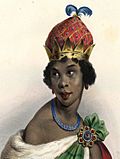
- Ana I de Sousa Nzinga Mbande: A famous warrior queen who ruled from 1631 to 1663.
- Verónica I Guterres Kandala Kingwanga: Ruled from 1681 to 1721.
- Ana de Sousa Nzinga Mbande: Ruled from 1624 to 1626 and again from 1657 to 1663.
East Africa
Comoros
- Raketaka Jombe Sudy: Ruled from 1842 to 1865 and again from 1874 to 1878.
Ethiopia
- Zewditu: Empress from 1916 to 1930.
Kenya
- Elizabeth II: Queen of Kenya from 1963 to 1964.
Madagascar
- Ranavalona I: Ruled from 1828 to 1861.
- Rasoherina: Ruled from 1863 to 1868.
- Ranavalona II: Ruled from 1868 to 1883.
- Ranavalona III: Ruled from 1883 to 1897.
Mauritius
- Elizabeth II: Queen of Mauritius from 1968 to 1992.
Tanzania
- Elizabeth II: Queen of Tanganyika from 1961 to 1962.
Uganda
- Elizabeth II: Queen of Uganda from 1962 to 1963.
Southern Africa
Malawi
- Elizabeth II: Queen of Malawi from 1964 to 1966.
Namibia
Shambyu
- Maria Mwengere: Ruled from 1947 to 1987.
- Angelina Matumbo Ribebe: Ruled from 1989 to 2015.
- Sofia Mundjembwe Kanyetu: Began her reign in 2023.
South Africa
- Elizabeth II: Queen of South Africa from 1952 to 1961.
Lobedu people The Modjadji or Rain Queen is the traditional queen of the Lobedu people. The eldest daughter inherits the throne. The Rain Queen is believed to control clouds and rainfall.
- Maselekwane Modjadji: Ruled from 1800 to 1854.
- Masalanabo I Modjadji: Ruled from 1854 to 1894.
- Mokope Modjadji: Ruled from 1981 to 2001.
- Makobo Modjadji: Ruled from 2003 to 2005.
- Masalanabo II Modjadji
Zimbabwe
- Elizabeth II: Queen of Rhodesia from 1965 to 1970.
The Americas
North America
Canada
- Victoria: Ruled from 1837 to 1901.
- Elizabeth II: Ruled from 1952 to 2022.
Mexico
- Ix Yohl Ik'nal: Ruled from 583 to 604.
- Sak K'uk': Also known as Muwaan Mat, she ruled from 612 to 615.
Central America
Belize
- Elizabeth II: Ruled from 1981 to 2022.
Guatemala
- Wac Chanil Ahau: Also known as Lady Six Sky.
The Caribbean
Antigua and Barbuda
- Elizabeth II: Ruled from 1981 to 2022.
Bahamas
- Elizabeth II: Ruled from 1973 to 2022.
Barbados
- Elizabeth II: Queen of Barbados from 1966 to 2021.
Jamaica
- Elizabeth II: Ruled from 1962 to 2022.
South America
Brazil
- Maria I: Queen of Brazil from 1815 to 1816. She was also Queen of Portugal.
Guyana
- Elizabeth II: Queen of Guyana from 1966 to 1970.
Suriname
- Juliana: Ruled from 1954 to 1975.
Asia
East Asia
China
- Wu Zetian: Empress of China, ruling from 690 to 705. She was the only official reigning empress in Chinese history.
Japan
- Empress Suiko: Ruled from 593 to 628, for 35 years.
- Empress Kōgyoku: Ruled from 642 to 645, for 3 years.
- Empress Saimei: Ruled from 655 to 661, for 6 years.
- Empress Jitō: Ruled from 686 to 697, for 9 years.
- Empress Genmei: Ruled from 707 to 715, for 8 years.
- Empress Genshō: Ruled from 715 to 724, for 9 years.
- Empress Kōken: Ruled from 749 to 758, for 9 years.
- Empress Shōtoku: Ruled from 764 to 770, for 6 years.
- Empress Meishō: Ruled from 1629 to 1643, for 14 years.
- Empress Go-Sakuramachi: Ruled from 1762 to 1771, for 9 years.
Korea
South Asia
Bangladesh
Chakma Circle
- Kalindi: Ruled from 1832 to 1873.
India
- Qudsia Begum: The first female ruler of Bhopal, she ruled from 1819 to 1837.
- Begum Sultan Shah Jehan: Ruled from 1844 to 1860 and again from 1868 to 1901.
- Begum Nawab Sikandar: Ruled from 1860 to 1868.
- Begum Kaikhusrau Jahan: Ruled from 1901 to 1926.
- Victoria: Empress of India from 1876 to 1901.
Holkar dynasty
- Ahilyabai Holkar: Known as the Philosopher Queen, she ruled from 1767 to 1795.
- Rani Rudrama Devi: Ruled from 1262 to 1295.
- Didda: Ruled from 980 to 1003, first as a regent, then as the sole ruler.
- Razia Sultana: Ruled from 1236 to 1240.
Maldives
- Khadijah: Ruled three times (1347–1363, 1364–1374, and 1376–1380).
Pakistan
- Elizabeth II: Ruled from 1952 to 1956.
Sri Lanka
- Elizabeth II: Ruled from 1952 to 1972.
Southeast Asia
Cambodia
- Ang Mey: Ruled from 1835 to 1840 and again from 1844 to 1846.
Indonesia
- Seri Ratu Ta'jul Alam Shah: Sultana of Aceh from 1641 to 1675.
- Seri Ratu Kamalat Syah: Ruled from 1688 to 1699.
- Tribhuwana Wijayatunggadewi: Ruled from 1328 to 1350.
- Suhita: Ruled from 1429 to 1447.
Laos
- Nang Keo Phimpha: Ruled for a few months in 1438 at the age of 95.
Malaysia
- Puteri Saadong: Ruled from 1667 to 1671.
Myanmar
- Shin Sawbu: Ruled from 1454 to 1471.
Philippines
- Dayang Kalangitan: Ruled from about 1450 to 1500.
Thailand
- Ratu Hijau: 'The Green Queen', ruled from 1584 to 1616.
- Ratu Biru: 'The Blue Queen', ruled from 1616 to 1624.
- Ratu Ungu: 'The Purple Queen', ruled from 1624 to 1635.
- Ratu Kuning: 'The Yellow Queen', ruled from 1635 to 1651.
Vietnam
- Queen Trưng Trắc: She and her sister led a rebellion against Chinese rule from 40 to 43 AD. They are national heroines.
- Lady Triệu: Ruled in 248 AD.
- Empress Lý Chiêu Hoàng: Ruled from 1224 to 1225.
West Asia
Iran
- Thea Musa: Parthian queen who ruled with her son from 2 BC to 4 AD.
- Boran: Sasanian queen who ruled in 630 and again from 631 to 632.
- Azarmidokht: Sasanian queen who ruled from 630 to 631.
Iraq
- Puabi: A queen from about the 26th century BC, believed by some to have ruled on her own.
Israel
- Athaliah: Ruled from 843 to 835 BC.
- Salome Alexandra: Ruled from 76 to 67 BC.
- Melisende: Ruled from 1131 to 1153, often with her husband or son.
- Isabella I: Ruled from 1190/92 to 1205, with her husbands.
Saudi Arabia
Syria
- Zenobia: Ruled briefly as empress in 272 AD.
Turkey
- Isabella: Ruled from 1219 to 1252, co-ruling with her husband from 1226.
- Artemisia I: Ruled around 480 BC.
- Artemisia II: Ruled from 353 to 351 BC.
- Ada: Ruled from 344 to 340 BC and again from 334 to 326 BC.
Yemen
- Asma bint Shihab: Co-ruler of Yemen from 1047 to 1087. She was one of the few female monarchs in the Arab world to be publicly recognized in mosques.
- Arwa al-Sulayhi: Ruled Yemen from 1067 to 1138. She was a very important ruler and the first woman to be given a special religious title in her faith.
Central Asia
Uzbekistan
- Tomyris: Queen of the Massagetae, ruled from about 570 to 520 BC.
Europe
Central Europe
Austria, Hungary, Croatia, and Czechia
- Mary: Queen of Hungary and Croatia from 1382 to 1385 and again from 1386 to 1395.
- Maria Theresa: Archduchess of Austria and Queen of Hungary, Croatia, and Bohemia. She ruled from 1740 to 1780.
Poland and Lithuania
- Jadwiga: Queen of Poland from 1384 to 1399.
- Anna: Queen of Poland and Grand Duchess of Lithuania from 1575 to 1587.
Eastern Europe
Georgia
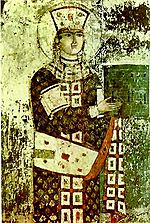
- Tamar of Georgia: Ruled from 1184 to 1213.
- Rusudan of Georgia: Ruled from 1223 to 1245.
Russia
- Catherine I: Empress from 1725 to 1727.
- Anna: Empress from 1730 to 1740.
- Elizabeth: Empress from 1741 to 1762.
- Catherine II: Empress from 1762 to 1796. She is one of the most famous Russian rulers.
Northern Europe
Denmark, Norway and Sweden
- Margaret I: Queen of Denmark (1387–1412), Norway (1388–1412), and Sweden (1389–1412). She united these kingdoms.
- Christina: Queen of Sweden from 1632 to 1654.
- Ulrika Eleonora: Queen of Sweden from 1718 to 1720.
- Margrethe II: Queen of Denmark from 1972 to 2024.
Western Europe
Netherlands
- Wilhelmina: Queen of the Netherlands from 1890 to 1948.
- Juliana: Queen of the Netherlands from 1948 to 1980.
- Beatrix: Queen of the Netherlands from 1980 to 2013.
Monaco
- Louise Hippolyte: Ruled in 1731.
United Kingdom and Ireland
- Cartimandua: Queen of the Brigantes in Northern England, ruled around 43 to 69 AD. She was loyal to Rome.
- Boudica: Queen of the Iceni people in Eastern Britain. She led a major uprising against the Roman Empire around 60 to 61 AD.
- Mary I of Scotland: Queen of Scotland from 1542 to 1567.
- Mary I of England: Queen of England and Ireland from 1553 to 1558.
- Elizabeth I: Queen of England and Ireland from 1558 to 1603. She was a very powerful and famous queen.
- Mary II: Queen of England, Ireland, and Scotland from 1689 to 1694. She ruled with her husband.
- Anne: Queen of England, Scotland, Ireland, and later Great Britain, from 1702 to 1714.
- Victoria: Queen of the United Kingdom from 1837 to 1901.
- Elizabeth II: Queen of the United Kingdom from 1952 to 2022.
Southern Europe
Albania
- Caeria: Queen of Illyria, ruled until 344/343 BC.
Cyprus
- Charlotte: Ruled from 1458 to 1464.
- Catherine Cornaro: Ruled from 1474 to 1489.
British Cyprus
- Victoria: Ruled from 1878 to 1901.
- Elizabeth II: Ruled from 1952 to 1960.
Greece
- Irene of Athens: Empress from 797 to 802. She was a co-ruler from 792.
- Zoë Porphyrogenita: Ruled from 1028 to 1041 and again from 1042 to 1050. She ruled with her husbands and sister.
- Theodora Porphyrogenita: Ruled from 1042 to 1056, first with her sister, then alone.
Italy
Ostrogothic Kingdom
- Amalasuintha: Ruled from 534 to 535, first as a regent, then as queen.
- Constance I: Ruled from 1194 to 1198, co-ruling with her husband.
- Maria: Ruled from 1377 to 1401, co-ruling with her husband.
- Joan the Mad: Ruled from 1516 to 1555. She was also Queen of Castile and Aragon.
Kingdom of Naples
Portugal
- Maria I: Queen of Portugal from 1777 to 1816.
- Maria II: Queen of Portugal from 1826 to 1828 and again from 1834 to 1853.
Spain and Andorra
- Isabella I: Queen of Castile and León from 1474 to 1504. She was a very important queen in Spanish history.
- Catherine: Queen of Navarre and Co-Princess of Andorra from 1483 to 1517.
- Joanna: Queen of Castile, Aragon, and Navarre from 1504 to 1555.
- Isabella II: Queen of Spain from 1833 to 1868.
Malta
- Elizabeth II: Queen of Malta from 1964 to 1974.
Oceania
Australasia
Australia
- Victoria: Ruled in 1901.
- Elizabeth II: Ruled from 1952 to 2022.
New Zealand
- Elizabeth II: Ruled from 1952 to 2022.
- Makea Takau Ariki: Queen/Supreme High Chiefess of the Cook Islands from 1871 to 1911. She was the last monarch of the Kingdom of Rarotonga.
Melanesia
Fiji
- Elizabeth II: Ruled from 1970 to 1987.
Papua New Guinea
- Elizabeth II: Ruled from 1975 to 2022.
Solomon Islands
- Elizabeth II: Ruled from 1978 to 2022.
Polynesia
American Samoa
- Matelita: Ruled from 1891 to 1895.
French Polynesia
Bora Bora
- Teriimaevarua II: Ruled from 1860 to 1873.
- Teriimaevarua III: Ruled from 1873 to 1895.
- Teha'apapa II: Ruled from 1868 to 1893.
- Teha'apapa III: Ruled from 1893 to 1895.
- Pōmare IV: Ruled from 1827 to 1877.
Hawaii
- Liliʻuokalani: The only queen of the Kingdom of Hawaii, she ruled from 1891 to 1893.
Tonga
- Salote Tupou III: Ruled from 1918 to 1965.
Tuvalu
- Elizabeth II: Ruled from 1978 to 2022.
Legendary and Mythological Monarchs
These are women who are said to have ruled in ancient stories or myths.
China
- Nüwa: One of the Three Sovereigns, ancient rulers of China.
Egypt
- Nitocris: Mentioned by Herodotus as the last pharaoh of the Sixth Dynasty.
- Daluka: An ancient queen who supposedly built a wall around Egypt.
Ethiopia
- Makeda: The Biblical Queen of Sheba in Ethiopian tradition. She was the mother of Menelik I.
Greece
Amazons
The Amazons were a group of fierce female warriors and rulers in Greek myths.
- Hippolyta: An Amazonian queen known for her magical girdle.
- Penthesilea: A daughter of Ares, the god of war.
India
- Yashovati: A ruler of Kashmir mentioned in old writings.
Iraq
- Kubaba: The only queen on the Sumerian King List, from the 25th century BC.
- Semiramis: A legendary queen of Assyria.
Japan
- Empress Jingū: Said to have ruled from 201 to 269.
Korea
- Lady Saso: An honorary queen of Silla.
Mexico
Aztec Empire
- Atotoztli II: Possibly ruled from 1466 to 1472, though this is debated.
Poland
- Wanda: A legendary female ruler of Bohemia.
South Africa
- Majaji: A legendary Rain Queen from around 350 AD.
United Kingdom
- Queen Gwendolen: A legendary queen from the 11th century BC.
- Queen Cordelia: A legendary queen from the 8th century BC.
Vietnam
- Lady Po Nagar: According to legend, she founded the Cham nation.
Images for kids




